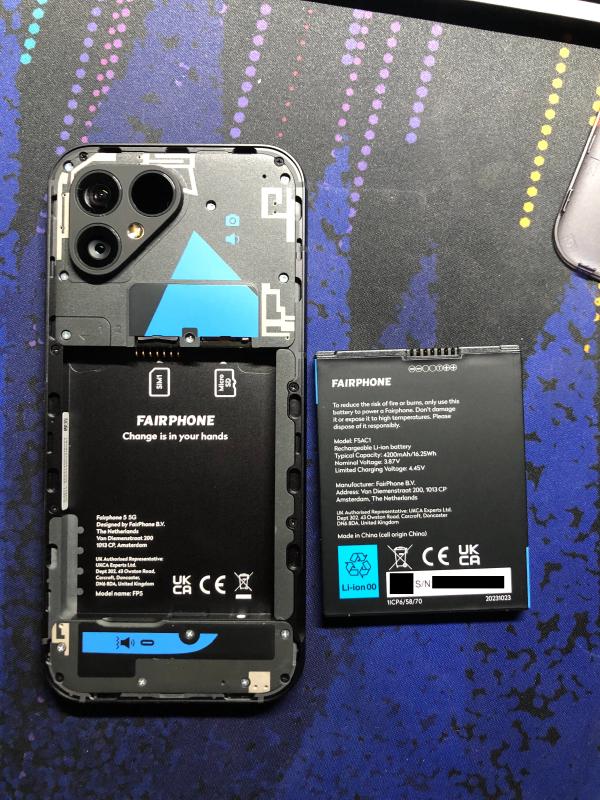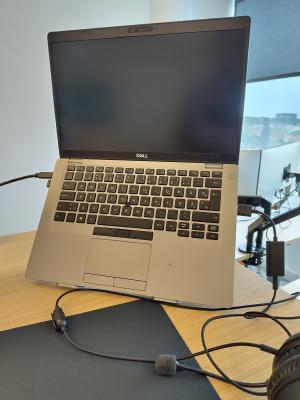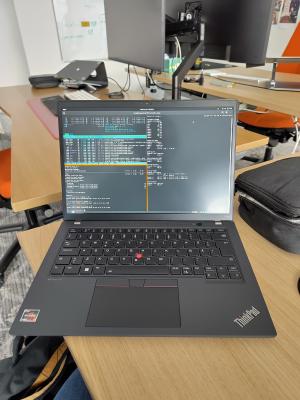Fairphone 5: a biased long-term review (281 days and counting)

Changelog:
- 2024-03-06: 58 days, initial post
- 2024-07-28: 202 days, still going strong!
- 2024-10-15: 281 days
After months of contemplating I finally pulled the trigger and got myself a Fairphone 5. The fact that iPhone X stopped receiving major iOS updates certainly helped make that decision.
“But why? My Xiaomi/Oneplus/Samsung/other glued-together device is like so much cheaper and faster and makes better photos and the software is good after I completely format it and install a custom ROM! And LinusTechTips said that it is trash!”
Well, it’s simple: Fairphone is the one of the few companies out there that has a good track record of long-lasting software support and the phones they produce are easily repairable.
The competition is catching on regarding the software support side, but at this time those claims have not been proven yet, unlike Fairphone.
They also make an active effort to make sure that the people behind the production of their phones are treated well.
These efforts need to be supported so that we don’t end up replacing our phones every few years because the manufacturer stopped releasing software updates or your battery died and you cannot easily replace it.
This post is not sponsored, I bought this phone with my own money. The iPhone X that I used before the Fairphone 5 got passed to someone else as an upgrade so this was not a vanity purchase.
tl;dr it’s a perfectly cromulent phone that comes with some intentional trade-offs that improve the repairability and longevity while reducing the environmental impact and human suffering.
For those who saw the LTT video: Fairphone made a response video where they address most concerns and explain some design choices and trade-offs that they made with the Fairphone 5.
The mission
I really admire what Fairphone is trying to achieve.
If you’re not sure what makes Fairphone special and different from others, then give their website a read. They also held a talk at FOSDEM 2024 which goes into more technical detail, describing their journey, goals, and challenges faced when building phones and trying to support existing ones for as long as possible (Qualcomm sucks in this regard).
In short: they build sustainable phones that you can use and repair for a very long time, made by people that get paid and treated fairly.
One of the not-so-fun facts from their FOSDEM 2024 talk was that it only takes a few extra dollars per phone to make sure that the factory workers get paid a living wage. Makes you think: if that is all it takes, then why aren’t other companies doing it?
My use case for a phone
It’s important to recognize that everyone uses their phone differently. Some expect great performance, especially if they play games. Some just want a good camera. Some just want to chat with their friends and family and share dank memes.
My expectations are very modest: a phone should make adequate pictures, be reasonably fast and get regular software updates. This post is written from my perspective and will likely conflict with your views on what a phone should be, keep that in mind.
The Fairphone 5 is the first one that I actually considered buying because it resembles a modern smartphone with relatively few compromises. This is in part thanks to the rate at which smartphones innovate slowing down, both in performance and the amount of new features that people actually care about.
The cool factor
I got the transparent edition, meaning that the backside of the phone is made out of semi-transparent plastic. I can at a moments notice flip the phone over and see the components, including the battery, SIM card and the microSD card. Absolutely unpractical, still cool though.

I wouldn’t do the “I can replace the battery in 30 seconds” party trick too much because I feel like the plastic clips holding the back cover in are quite fragile and can break if too much force is used. You can easily buy replacement covers, though.
The software
My first proper smartphone was a Samsung Galaxy Gio back in 2011. It was also my first introduction to custom ROMs and over the years I ended up running all sorts of phones with various flavours of Cyanogen and LineageOS. At one point certain banking and e-ID related apps began blocking users who decided to run custom ROMs, so I went to the Apple side for a few years.
Why this preface? Well, it’s because coming back to the Android side of things felt so refreshing and freeing.
I can:
- finally run a real version of Firefox on my phone
with an actual ad blocker.
- this is an absolute gamechanger for me and something I sorely missed on iOS
- install any app that I want.
- there are also a lot more FOSS apps available.
- rearrange shortcuts on my home screen as I want to.
- or hell, run a different launcher altogether
- seamlessly back up photos from my phone to PC using Syncthing!
- work with actual files!
- cram in a 512GB microSD card.
The Fairphone 5 ships with Android 13, with Android 14 upgrade currently scheduled to summer 2024. The base OS is quite clean, the only preinstalled app (other than the Google stuff) is the “My Fairphone” app that shows information about your device. That same app can also be used to verify that the functionality on your phone works, and yes, the speaker testing ones get quite loud.
If you decide that the stock Android experience isn’t for you, then know that this phone can easily run alternative operating systems. At FOSDEM 2024 almost every alternative OS booth had one or more Fairphone 5 running, including Ubuntu Touch and CalyxOS. It’s clear that the FOSS community has embraced the Fairphone.
I was a bit sad to see that a lot of open source apps that I used to run or that come up in searches are unsupported or out of date. In some cases modern forks exist, but overall the picture looks very discouraging, especially if I was new to the scene.
Performance
The performance isn’t great, but it’s good for most activities. I can feel it being sluggish from time to time or with certain animations.
This is due to an intentional trade-off that Fairphone made: to be able to properly support this device for a very long time, they had to go with a Qualcomm SoC that gets long-term support, and that ruled out the ones that provide the best performance. They ended up putting in a chip that was designed for IoT applications, funnily enough. If having a slightly slower phone is what is needed to run this phone for 5+ years, then it’s a worthwhile trade-off in my view.
Fairphone highlighted the OEM support issue in their FOSDEM 2024 talk in case you’re curious about why this trade-off needed to be made. My opinionated tl;dw: we have to get OEM-s to either open source the proprietary parts or hit them with some regulations and enforcement so that they do support the chips they produce for longer.
Battery life
The battery life is what you would expect from a typical smartphone: 1-2 days of normal use, but I once stretched it to almost 4 days during a time when I used my phone very little. Do note that this is highly dependent on your usage patterns, if you do constant video calls then you can’t expect the battery to last much.
If you want to extend the longevity of your battery, then there is an option to limit charging to 80% in battery settings. I’ve recently enabled it because it doesn’t impact my use of the phone much. Let’s see how it fares in a few years.
Size and feeling
This phone is big. Really big. Biggest one I’ve had yet.
I actually prefer smaller phones, something like the iPhone 13 mini size would be ideal (Apple stopped making smaller phones that aren’t iPhone 7 reskins after that so that’s not an option any longer). When I was in a store that sold iPhones, I compared my phone to the latest iPhone 15 offerings and was surprised to see that my phone was about the same size as an iPhone 15 Plus. Hopefully we’ll see smaller Fairphones in the future, all while not introducing too many compromises.
Some people are surprised at the thickness of the Fairphone 5. Yes, it’s thicker than most of the competitors, but note that with other phones you’ll likely buy a separate case for the phone, so you’ll end up with something just as thick anyway. At least with Fairphone 5 you don’t have a glass backside that easily shatters if you drop it.
Camera
When I bought the phone, I expected only one thing from the Fairphone 5: its camera should be better than the one on the iPhone X. GSMArena comparisons and reviews by others looked promising
The camera on the Fairphone is acceptable. I don’t have proper photography education, but in most cases the Fairphone makes OK pictures. In low light situations it seems to be inferior to flagship phones from other companies, which may often end up with smudged pictures. At least it has a low light mode, something that my previous phone (iPhone X) lacked. The colors look funky sometimes and are oversaturated.
This is a selection of photos made with the Fairphone 5. Thumbnails are compressed to avoid unnecessary bandwidth. Click on the image to view the original, full-sized version.











The headphone jack
I feel like I’m obliged to mention that this Fairphone doesn’t have a headphone jack. As someone who spent a few years on iPhones, this one doesn’t bother me too much.
USB-C port
I plugged it into an USB-C dock and it actually output to an external display in portrait mode. Not sure how practical, but really cool.
Oh, and the USB-C port is easily replaceable.
Price
If you only focus on the spec sheet and compare the Fairphone 5 to the competition, then it will strike you as an expensive phone, coming in at 699 EUR.
It is expensive, but that’s a result of a lot of small things. Fairphone tries to do their best to source the raw materials from ethical sources and that narrows down your selection by a lot. Add to that living wages to the factory workers, more repairable components, declining to add sponsored apps/ads into the OS and that’s the result.
If you take the price and divide it by the number of years that you expect to get out of this phone (5-10 years), then the price is likely much more comparable to the competition.
If a higher purchase price results in less human suffering and a longer lifetime of the device, then so be it.
Schematics
They provide schematics for the phone (direct link here).
My hours of watching Louis Rossmann do board level repairs have taught me that this is a very good thing.
It’s not perfect
Every phone has issues.
iPhone 15 had overheating problems.
That one iPhone SE 2020 that I ran for a few months had a hard to reproduce system board issue that made the phone inoperable for 5+ minutes in random situations.
Here are some issues that I’ve noticed while using the Fairphone 5
SIM card
After I set up the phone, the SIM card would stop functioning properly after a few hours of use. Reseating the SIM card did not work, and I was quite frustrated because I was expecting to send the phone back just after I set it all up. Luckily it seem to be a known issue and there is an official support article that covers it. My SIM card is much older than the specified 2 years, but I couldn’t be arsed with replacing it yet so I used pure ethanol to clean the contacts on the SIM card, popped it back in and it has worked with absolutely no issues ever since. I’m glad that I got this easily fixed, but for a normal customer this would be a very frustrating experience so hopefully there is something that Fairphone can do to fix and/or avoid this in the future.
The display
The display of the Fairphone 5 supports 90 Hz refresh rate, but ships with it set to 60 Hz. I’ve heard that most other phones do something similar with the likely reason being the negative impact that high refresh rate displays have on the battery life. At the time of writing, however, there is a known issue with the 90 Hz mode which can actually result in more lag and a worse user experience. I’ve set the display back to 60 Hz for this reason. Luckily this is something that can probably be fixed with a software update.
The automatic brightness setting is quite bad, especially when compared to any iPhone. The brightness jumps around a lot in darker conditions and it’s very irritating when driving because random street lights and cars seem to trigger the sensor often. Again, probably something that can be fixed in software.
Software stability
Overall the software is stable, but there was this one time when the phone crashed and rebooted unexpectedly. It was triggered while playing music and opening a Snapchat notification. Nothing serious and has only happened once in an almost two-month period, but still noteworthy.
The Google crapware
This isn’t really a Fairphone issue, but more of an Android gripe. I still have to mention it though. The Android 13 experience has started resembling the Windows experience. I had to toggle off countless “features” to turn off most of the Google crapware that ships with the phone, and even then I still have to stare at the unremovable Google Search bar at the home screen. That thing takes up so much useful screen real estate and is absolutely useless to me. It used to be removable according to some discussions I found online, but I guess Google noticed that feedback and made it a permanent fixture on the home screen with an update. Absolutely disgusting. You can work around this by using a launcher that’s not affected by Google. Kvaesitso is a FOSS one that seems to work well enough for me.
Final thoughts
Fairphone 5 is what you get when you focus on delivering a phone with long-term support and repairability in mind, all while doing your best to treat your workers well. This does mean that you’ll be making some trade-offs.
You won’t get the best performance, the best camera, or the smallest size. What you get in return is the ease of repairability, years of software updates with a proven track record, and the knowledge that at least those workers who assembled your phone get paid a living wage.
If you don’t expect much from a phone and are willing to pay more for a phone that you can use for a lot longer, then the Fairphone 5 is a good option.
Can I make it to 2031 with this phone? I’ll definitely give it a try.
2024-07-28 update: 202 days
My Fairphone 5 is still going strong. Here are some notes after 202 days of use.
Android 14
The promised Android 14 update is here and on time. The upgrade took a while to install but was boring, in a positive way. Nothing I relied on broke and the interface looks more-or-less the same.
The only aspect I’m not happy about with the Android 14 update is the USB webcam mode feature not being present. It’s possible that it’s an optional feature of Android 14, and none of the Fairphone 5 materials indicate it being included.
Video playback issues
I’ve noticed some oddities regarding video playback. The video playback can be choppy on higher resolutions, especially when I run them at 2x speed. Lower resolutions are fine. Sometimes the issues only occur with certain encodings, like H.265, or audio tracks where I can only seem to hear certain audio channels.
Camera in action
The camera doesn’t seem to be the best option for point-and-shoot situations where there is a lot of movement or where the lighting conditions are bad. I’ve taken my fair share of blurry photos as a result. The included microphone also seems lacking in real life use, especially when I accidentally cover them with my fingers.
If I could pick one improvement for the next Fairphone, then it will have to be the camera. A lot of people care about camera quality and might rule out getting a Fairphone as a result.
At least with the pro mode you have a lot of control over the camera, which is great for more stationary shots.
Durability
I have nothing bad to say about the durability here. I have dropped it a few times already and as a result I have two small dings on the aluminium frame.
The backside has also held firm. After one fall a couple of clips came loose, but I could easily pop them back in.
Various oils and finger grease have an interesting effect with the transparent case, resulting in the see-through effect being better. The grip has gotten better with time and negates any need for a separate case. The Fairphone 5 is still a big phone and not that easy to handle one-handed, but the grippy backside makes up for part of it.
The display glass has a few scratches, but nothing too bad. I can’t seem to find any serious scratches on the backside.
Battery
The battery has held up fine. I turned off the battery saving feature because of how simple it is to replace the battery, enabled fast charging because it’s really handy, and stopped showing the battery percentage on the notification bar to reduce battery anxiety.
5G
I switched mobile service providers during this time and could finally test the 5G capabilities of this phone. Since I went with the cheapest option at the time, then the signal strength will not be as good as with other ones, but at least I know it works in Estonia.
Maximum speeds I’ve seen are around 250 Mbit/s. Could be limited by Fairphone 5, or the service provider (more likely option).
Display brightness
At some point I got an update that seems to have improved the automatic brightness feature. It’s not as jarring as before, especially at low light levels. I’m not sure which update fixed it, but I haven’t noticed any annoyances with it for a long time.
2024-10-15 update: 281 days
I have one gripe with the software support on Fairphone 5.
The security updates are lagging behind way too much.
They’ve always come with a small delay of a few weeks, but it took over a month to get the 5th of September security patches. These are supposed to be monthly.
I finally received the 5th of September security patches today, 15th of October. There’s already a new security bulletin out with the October patches, which I don’t have on my phone.
It’s better than no updates at all, but this does not bode well for future long-term software support.
Next update coming whenever!
Subscribe to new posts via the RSS feed.
Not sure what RSS is, or how to get started? Check this guide!
You can reach me via e-mail or LinkedIn.
If you liked this post, consider sharing it!
